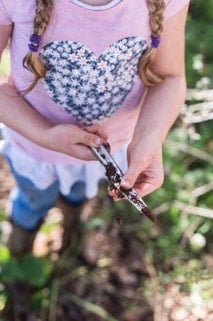Introducing gardening can be a great way to fuel a sense of curiosity and enhance connection to nature in children.
It can also be a creative way to spark their interest in eating more plant-based foods.Including gardening-based curriculum in early childhood development has gained significant momentum in recent years and has been studied from different angles. 
A systematic review on school garden programs has suggested some level of increased engagement for students who struggle in school (Ohley, et al., 2016). These findings could suggest impact on performance outcomes and could be supportive for garden-oriented programs in neighborhoods that face certain disparities.
Other studies have found some relationship between the introduction of experience based curriculum around gardening to have some positive effect on children with regards to consuming and favoring vegetables. A study led by Savoie-Roskos, Wengreen, and Durward found a small, positive influence on intake of fruits in vegetables when children participate in school gardening programs (2017). While another research project that addressed family health through the introduction of on-site food gardens into early childhood education has been commended for its impact as a community-based intervention (Chaufan, Yeh, & Sigal, 2015).  First
First
Garden-based nutrition programs are also being assessed for impact on obesity.
The current body of evidence has suggested that the programs are feasible to implement , such as demonstrated by a project led by the University of Texas, while larger size studies reflecting behavioral outcomes are still pending, (Sharma, Hedberg, Skala, Chuang, & Lewis, 2014).
We are also beginning to see publications that address early childhood development programs centered on gardening in settings other than school, such as detailed by Ryan-Krause in Pediatric Nursing (2018). Our finding from school-based programs could be opening the door for other settings that reach children and influence their eating-habits.
As we continue to discuss eating more greens as a way to live more healthful, Good Fat Company wanted to share a little more into what is going on with youth-based garden programs and, therefore, a few of the highlights have been synthesized in this blog post. 
It is exciting to observe the increase in interest and implementation of various programs around youth and gardening. It appears that they may serve as a potential catalyst for our future generations to eat in whole-food and healthful ways.
Ashley Arnold
Ashley runs a lifestyle health coaching service centered on evidence-based behavioral change and systematized approaches from integrative health services and healthcare. She includes functional health assessment tools that support setting more clear, realistic goals that are tailored to each client. She appreciates the products and mission of Good Fat Company due to the emphasis on whole-food, nutrition-rich products without processed additives or fillers. Also, that the product line is applicable across dietary spectrums from vegan to paleo and most anywhere in between. Further information can be found at www.ashleylarnold.com.
References:
Chaufan, C., Yeh, J., & Sigal, B. (2015, Apr). Advancing Family Health Through the Garden of Eatin’: on-site food gardens in early childhood education. American Journal of Public Health, 105(4), 625-628.
Ohley, H., et al. (2016, Mar 25). A Systematic Review of Health and Well-being Impacts of School Gardening: Synthesis of Quantitative and Qualitative Evidence. BMC Public Health, 16(286).
Ryan-Krause, P. (2018, Jul/Aug). Gardening: A Path to Development and Health. Pediatric Nursing, 44(4), 191-195, 201.
Savoie-Roskos, M. R., Wengreen, H. & Durward, C. (2017, Feb). Increasing Fruit and Vegetable Intake Among Children and Youth through Gardening-based Interventions: A Systematic Review. Journal of the Academy of Nutrition and Dietetics, 117(2), 240-250.
Sharma, S. V., Hedberg, A. M., Skala, K. A., Chuang, R., & Lewis, T. (2015, Aug 6). Feasibility and Acceptability of a Gardening-based Nutrition Education in Preschoolers from Low-income, Minority Populations. Journal of Early Childhood Research, 13(1), 93-110.


